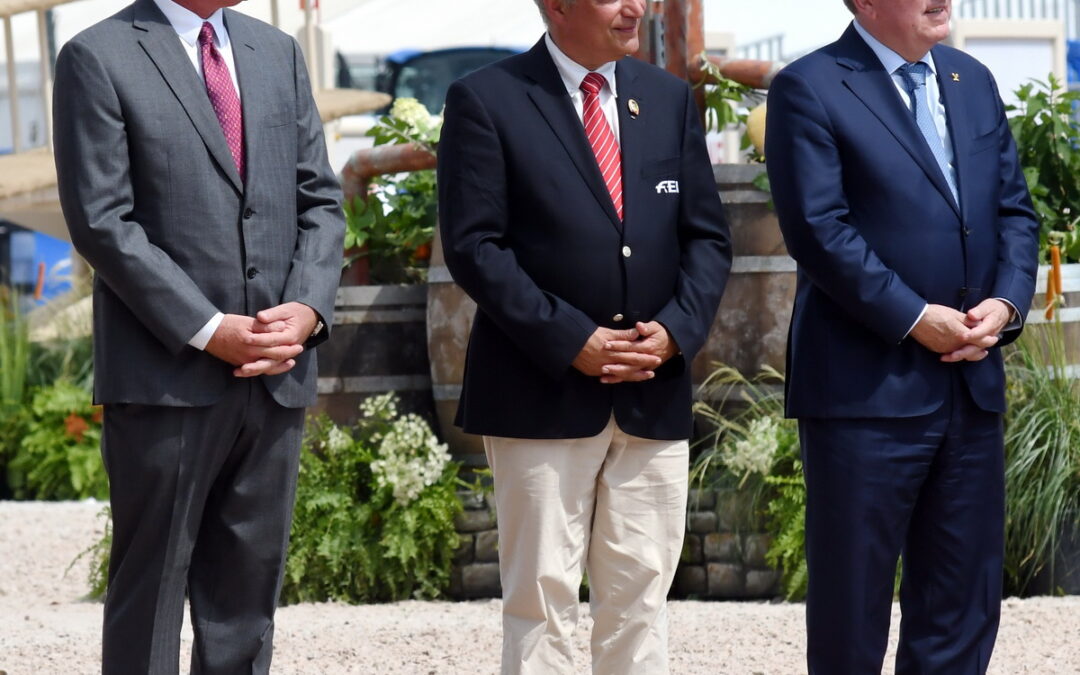
by Nancy Jaffer | Jan 14, 2025
Mark Bellissimo hasn’t always been the most popular person in Wellington, Fla. That’s the case even though he revitalized the Winter Equestrian Festival when he bought and improved its showgrounds, and established a special venue for dressage nearby.
Resident Ann Schneeberger explained on social media a year ago why some in town are bitter about him: “After years of ignoring restrictions, bending & breaking rules, lack of maintenance on his properties, accumulating fines…and dismissal of anyone who challenged him, many of us are not willing to forgive and forget.”
So when plans were revealed for removing Equestrian Village, home of the Global Dressage showgrounds, from the Equestrian Preserve and changing the zoning to allow development of The Wellington, a high-end golf community, residents expressed concern about the extent of Bellissimo’s involvement.
During hearings about the development, it was maintained more than once by Wellington Lifestyle Partners’ CEO Doug McMahon that Bellissimo was not playing a major role in the entity seeking the development. Yet many were skeptical.
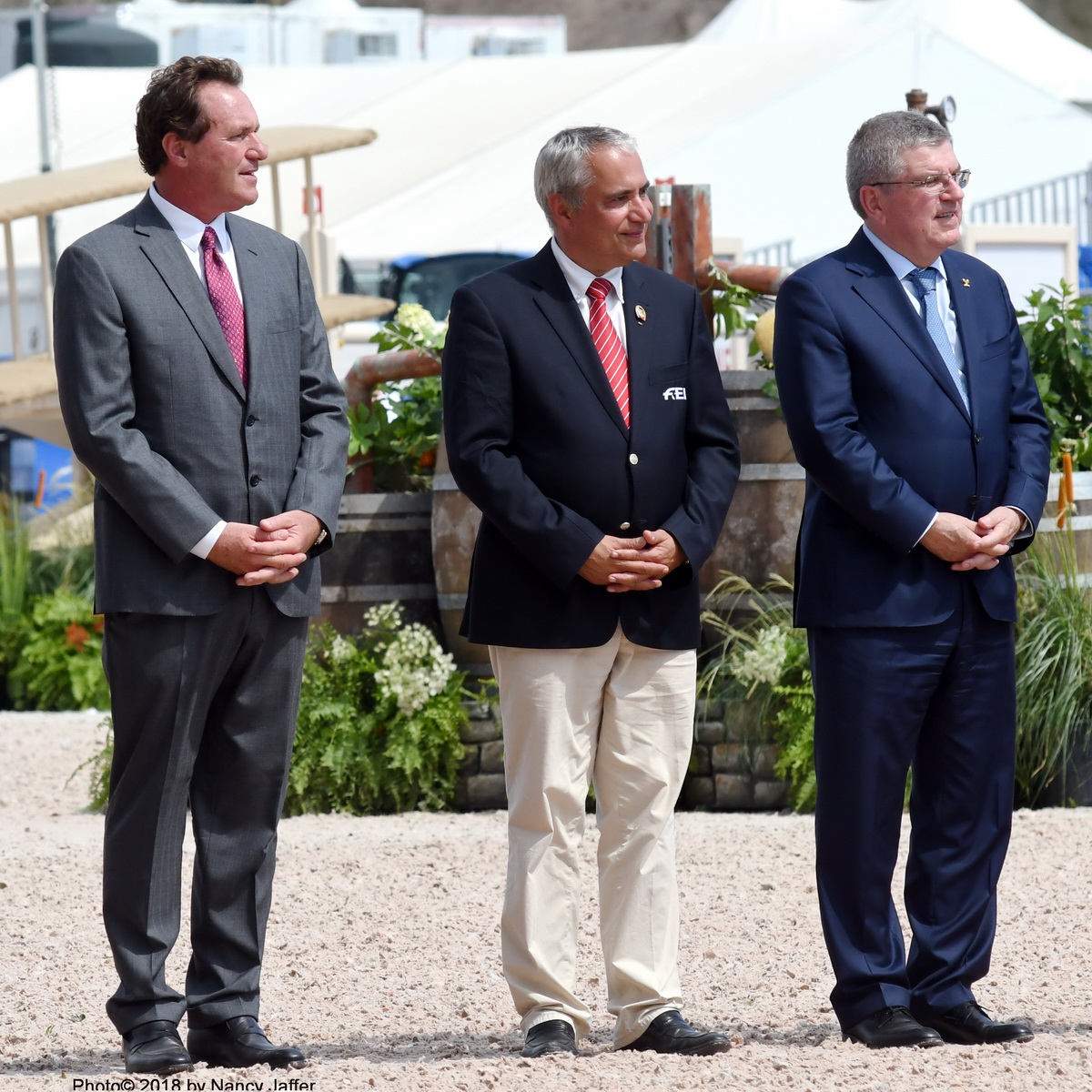
Mark Bellissimo with FEI President Ingmar de Vos and International Olympic Committee President Thomas Bach.
At a session on the project in January 2024, Councilman John McGovern asked McMahon about the “10,000-pound gorilla in the room: Is this going to be a project run and operated by Mark Bellissimo?”
“No,” McMahon replied firmly. But during more than 70 hours of hearings on the project, Bellissimo’s daughter, Paige Bellissimo Nunez, was often in evidence, answering questions and supplying information.
In November 2023, after the Wellington Village Council voted to take land out of the Equestrian Preserve for the golf development, former Councilman Micheal Drahos (now a member of the Village Planning, Zoning and Adjustment board) contended with what turned out to be a startlingly inaccurate insight, “Mark Bellissimo is out of gas. To his credit, I think he has recognized that what he wishes to accomplish in this town he can’t get done.”
How far from the truth that turned out to be. Hardly out of gas, Bellissimo is operating on high-octane, accomplishing everything he set out to do.
On Tuesday, it was announced the Wellington Lifestyle Partners, branded as a real estate development and hospitality company, has expanded its partnership as its portfolio grew to include the Wellington International showgrounds and operations, and the Wellington, its new private residential club community developed by NEXUS Luxury Collection. Bellissimo, who had sold the showgrounds three years ago to Global Equestrian Group, bought it back last fall in conjunction with some of the original partners.
Jeff Skoll, the first president of eBay and a shareholder in WLP with Bellissimo, Marsha Dammerman, Lisa Lourie, Roger Smith and NEXUS, has made another significant investment in the partnership. He is an active horse owner in support of Olympic-caliber riders.
Also joining WLP is Michael Smith, a former president of the Upperville, Va., Colt and Horse Show. Smith, who ran the second-largest independent rendering operation in the U.S. before retiring, is an amateur rider and owns several horses being ridden by Olympic multi-medalist McLain Ward.
“We are thrilled to have the support of our existing and new shareholders as we invest broadly in the Village, creating The Wellington club community with NEXUS and expanding the showgrounds,” Bellissimo stated in a press release.
“Ensuring Wellington is the quality standard for equestrian living is our goal.”
The Wellington, the new 400-acre luxury residential club community featuring 253 residences, along with championship golf and an array of sporting and wellness amenities, offers five types of housing, from custom estate homes and equestrian villas to four-acre equestrian farm estates.
The community’s golf course and amenities are being designed by golf architect David McLay Kidd of DMK Golf Design, known for his work at Bandon Dunes, Mammoth Dunes and Fancourt. The community’s master plan and core amenities are being designed by noted architecture and design firm Workshop/APD.
WLP will be launching a Founder’s program this month, inviting the first families interested in joining the club community and establishing a home in The Wellington, and will be staggering the release of its real estate offerings.
In addition to The Wellington, the company’s Village of Wellington portfolio includes The Wanderers Club, other land holdings and now Wellington International, the showgrounds home of the Winter Equestrian Festival and other horse shows.
“Speaking for all the shareholders, we are committed to Wellington long-term and creating assets here of the highest quality,” stated Skoll.
“The Wellington will be a world-class lifestyle community within Palm Beach County and will enhance Wellington’s position as the premier horse sport community in the world,” he contended.

by Nancy Jaffer | Jan 9, 2025
Wellington, Florida’s Equestrian Preserve Committee was skeptical about plans for a proposed development’s equestrian club, with a 24-stall barn whose occupants would include retired and rescue horses, to be used for riding experiences ranging from hunter/jumper, dressage and polo, to vaulting and endurance.
The concept was presented to the panel on Wednesday, with the equestrian portion as justification for a zoning change from equestrian residential to equestrian planned unit development for the 79.171-acre Isla Carroll property adjacent to the National Polo Center (formerly the International Polo Club) off 120th Ave. South.
After nearly three hours of discussion, the committee disapproved that request, as well as one involving an adjustment to the Equestrian Overlay Zoning District in the Village’s Master Plan.
Isla Carroll, with fields used for polo, was purchased in 2022 by Frank McCourt, one of the founders of the Global Champions Tour, and is a joint project with the high-end Discovery Land developer. Discovery specializes in club communities. Many of those 34 entities are devoted to golf, and located in such luxe locations as the Bahamas, Hawaii and the Hamptons – you get the picture.
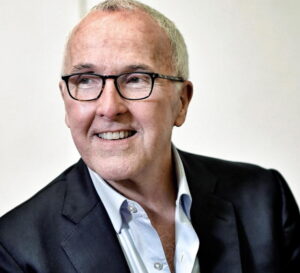
Frank McCourt
“We embrace the theme of the activities of the area,” Ed Divita, one of Discovery’s founding partners, told the committee about the clubs’ concepts. There was mention of Discovery’s Silo Ridge Field Club development in Amenia, N.Y., which hosts a 5-star international show jumping competition.
But although the possibility of staging horse shows at Isla Carroll was mentioned, they would have to be small and probably unlicensed—Florida is overflowing with horse shows.
Divita said the approximately 35 single-family lots on a minimum of a third of an acre probably would sell in the $4 million-$7 million range. Five more homes could be on 1.5- or 2-acre lots.
While there may have been some appeal to the multi-discipline equestrian blend he put forward, the context was all over the place, with talk about bringing in school children to learn about horses as one of several possibilities.
“The concept was not thought through,” said EPC member Kristy Lund, while others on the panel offered similar assessments. It was pointed out that the defunct Palm Beach Riding Academy nearby had been designed to introduce people to riding, but couldn’t make it work. Wellington is geared to higher-end equestrian pursuits.
“Wellington doesn’t cater to beginners,” pointed out committee member Ash Atkinson, who is a trainer.
There also was concern about the old barn on the site, with small stalls that had been used for polo ponies. It is in disrepair, and it was suggested that it should be torn down rather than renovated.
While noting Divita said homeowners are not required to join the club, he insisted, “equestrian is the theme” of the development. But committee member Sarah Goos responded, “I am confused how this is an equestrian development.”

The yellow rectangle is the Isla Carroll project site.
Another member, Kirsten Kopp, said, “I have no doubt this team would create a beautiful, wonderful luxury lifestyle community, but it would not fit my definition of an equestrian lifestyle community. It would not fit my definition of Wellington.”
She sees the Village as “a lot of open green spaces and when it’s not, it’s open arenas, that’s what defines it for us, bridle paths that connect to the rest of the community. It’s not defined by a luxury package; it’s defined by a common passion beyond fences and boundaries.”
Kopp suggested the proposed “equestrian community” is “kind of a pimple on the side of the rest…of what they presented here. You had to put it in to get the housing that you wanted.” She suggested breaking up Isla Carroll into “small boutique equestrian farms,” saying that “is the way to go.”
During the public hearing, River Run Farm owner Phoebe Weseley said, “This does not belong in the Equestrian Preserve. This is not an equestrian community. If it was really an equestrian community, there would be the homes and there would be the barns. There wouldn’t be pickleball, there wouldn’t be a spa, there wouldn’t be tennis courts, etc. I’m not sure if any planned unit developments belong in the Equestrian Preserve at this point.”
Then Tim Gannon, co-founder of the Outback steakhouse chain and honorary chairman of the National Polo Center’s Wellington Polo Tour, said he sees the Isla Carroll development “being symbiotic with our club” (National Polo.)
He called Discovery “an incredible organization” saying “they’re people that commit to a project and stay with it.” Gannon added that the project would “allow people to taste equestrian life. That’s what this is about.”
The hearing raised the question of what “equestrian lifestyle” means to the Village that is known for its international shows and horse farms. Lund suggested on social media Thursday that “EPC will have the task of coming up with a definition of equestrian lifestyle as it pertains to Wellington” and urged people to give it some thought.
“Nobody knows what it means,” Weseley said during her time before the committee.
“We need to have something in writing so that we can all understand what that means and how we fulfill that aspiration.”
After covering more than 70 hours of hearings in 2023 and 2024 on the Wellington North and South project which landed a golf community on the Global Dressage grounds in the Equestrian Preserve, I had a sort of Groundhog Day feeling during the evening. EPC had turned down the Wellington North and South project as well, but in the end, the Village Council approved it. EPC is only an advisory group, like the Planning, Zoning and Adjustment Board, which would be next in line to screen this project before the Council gets the final word.
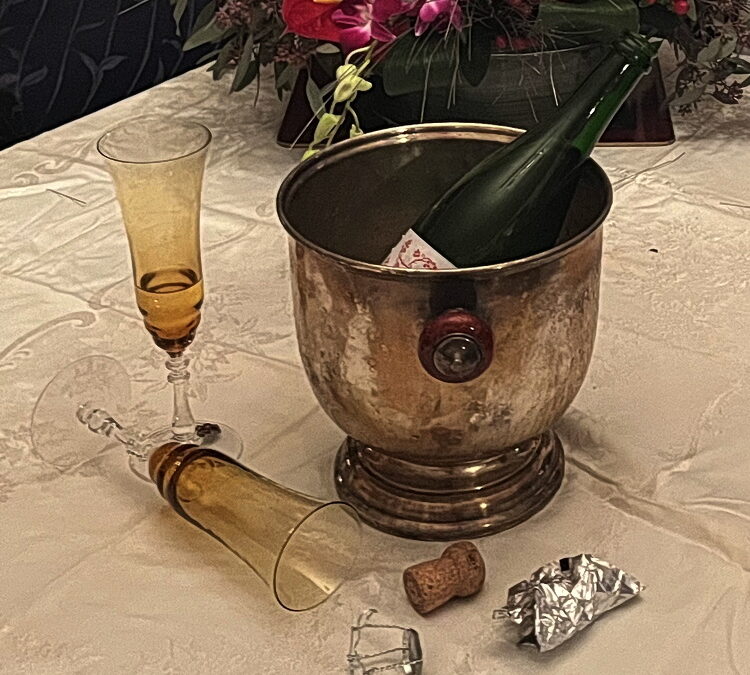
by Nancy Jaffer | Jan 3, 2025
The empty champagne bottles were recycled. The confetti scattered on the floor has been swept away. A few people returned to work at the end of this week; others will be heading there on Monday.
Back to reality. The holidays — which felt like quite a long stretch this time around — are over, along with time to reminisce about the year gone by. Horse shows and events are starting up again, so let’s take a look from an equestrian viewpoint at what’s in store for 2025.
The biggest issue likely will be the ever-increasing impact of Social License to Operate, or public acceptance of horse sport and to a certain extent, horse-keeping. One telling comment from last year was made by someone on social media who declared that the mechanical horse in the opening ceremonies of the 2024 Paris Games should be the only horse that takes part in the Olympics.
Scary, but even aside from SLO, there long has been concern whether equestrian disciplines can stay in the Games—especially considering the emphasis on attracting younger viewers with fast-moving, newer sports (break dancing and sport climbing anyone?) which also happen to be less expensive to stage than sports that require stabling, cross-country courses or shipping horses to a Games city from abroad.
Horse sport’s governing bodies are tightening rules with an eye toward SLO, although there often is justifiable impatience about the length of time it takes for offenders to be punished after they are suspended for horse abuse.
The U.S. Equestrian Federation last year voted for a rule change that expanded its ability to discipline those involved in unethical treatment of animals, reaching beyond the confines of the shows it licenses, even to the home stable of a member. Those who belong to USEF are expected to report any instances of abuse they witness. They can text 2USEF to express their concerns.
While USEF has yet to approve restrictions on whip use in horse shows, it has indicated that it will be open to doing that, if the language in a recent proposal is refined to better define it.
British Equestrian mandated five years ago that its riders carry padded batons rather than traditional whips, and as of January 1, these can only be used to reinforce leg aids or support the shoulder in directing the horse, never as punishment. That may well become the standard everywhere.
The blood rule, with varying standards of elimination for different disciplines, is rigid and there have been some calls for revision. Will that happen to some extent this year? Rather than relying on an official’s judgment about whether blood on a horse in competition is a welfare issue and not just an inconsequential mishap, the letter of the law is the guide for elimination of a competitor. Of course, no one wants spectators to see blood on a horse, but an insect bite or a slight scratch are hardly visible and likely negligible in terms of horse welfare. In cases where there is a question, can’t a veterinarian decide? The International Jumper Riders Club is particularly concerned.
World Horse Welfare’s research found that 20 percent of the public does not support any horse sport at all, anywhere; while 40 percent would support it if horse welfare is improved. But how many people really know what “improvements” are realistic, or even necessary?
The less experience the general population has with horses, as development gobbles up open country and stables, the easier it is for the anti-equestrians to make a case that doing almost anything with a horse is abuse. We take for granted that it’s obvious sport horses (and most pleasure horses, for that matter) are well cared-for. But since the majority of people have no idea what caring for a horse involves, they are open to suggestions that abuse is involved.
A little thing struck me during the Tournament of Roses parade on New Year’s Day, when one of the TV commentators said as an equestrian unit passed by, “Oh look, the horses are wearing leg-warmers.” They were, of course, wearing polo wraps, but it reminded me that few people have a clue about anything to do with horses, so they put perspective into their own context. On a larger scale, that can mean trouble.
Initiatives that show a caring link between people and horses, such as therapeutic riding opportunities or retraining of rescue horses and retired racehorses, are easily understood from a welfare perspective, so it’s important to give them support.
Reaching out to a wider audience via new concepts has real potential for helping broaden appreciation of horses and sport. HITS is debuting the Festival of the Horse™ in March at its Ocala, Fla., venue, where a multi-discipline, unrated competition format will offer classes for everything from the usual hunters, jumpers and dressage to western pleasure, Pony Club competition and arena eventing. The Festival also will be held at other HITS venues during the year in an effort to “unite the multifaceted equestrian community around a shared passion for horse sport.” What an interesting idea.
However optimistic you are about prospects for 2025, don’t expect an end to the continued rise in horse-keeping costs, from feed and veterinary care to the price of labor (if you can even find workers). It means less people can afford their own horses, or access to other people’s horses, factors that narrow the base of participants. Riding stables where beginners can get lessons without paying a fortune are in relatively short supply.
On the international front, the Europeans have their biennial championships in the major disciplines. But for the U.S., this is the relatively quiet year of the four-year Olympic cycle, with only FEI World Cup finals in Switzerland on the horizon as an international title meet. That competition will be more exciting when it is held in Fort Worth, Texas, during the spring of 2026. The World Championships are set for Aachen, Germany, a few months later in an unofficial reincarnation of the World Equestrian Games (minus endurance). The 2006 WEG in Aachen was the best of its genre, so the refresh two decades later is highly anticipated.
But in the meantime on this continent, the finals of the new U.S. Equestrian Federation open championships in the Olympic disciplines will be held in Virginia, Florida and California, a chance to bring along possible medal prospects and get enthusiasm into high gear for 2026 efforts. This is the year to build potential championship combinations who will have time to develop prior to the immense pressure of a major title meet. And there’s plenty to do before 2028, when Los Angeles will host the first Olympics in the U.S. since 1996.
On the bright side, there is always something to look forward to in the horse world, whether it’s your own goals, or going to a special equestrian happening. Major shows and events are much more spectator-friendly than they used to be, so attending them can make an outing an occasion, and offer a chance to introduce friends and family to horses.
In September, Dressage at Devon outside of Philadelphia will celebrate its fiftieth anniversary. The dressage scene and calendar have changed drastically since the debut of the heritage fixture at the Devon, Pa., showgrounds, because so many competitors and competitions have moved south. But Dressage at Devon has persevered and continues to be a goal for many in the discipline, especially in the Northeast and mid-Atlantic region.
Something else to look forward to this year is the reopening in New Jersey of the former Suburban Essex/Essex Equestrian Center stable in West Orange. The building that dates back more than a century is not falling victim to development. It is being renovated, while care has been taken to retain the memorable features that make it a unique facility which played an important role in so many lives over the generations. The project will be a base for hunter/jumper trainer Brianne Goutal-Marteau, whose husband, Romain Marteau, is overseeing the refurbishment.
If you haven’t already given up on your New Year’s resolutions, why not make one or two more? How about vowing to be a good ambassador for horses and sport, taking the time to welcome those who express interest, however casual. Why not become a volunteer for a competition, a rescue operation or any other equestrian organization that needs assistance or is a good cause? And if you have the interest and ability, consider learning to be a judge or steward. There’s always something you can do to help, which will pay off in a better experience with horses for everyone to enjoy.
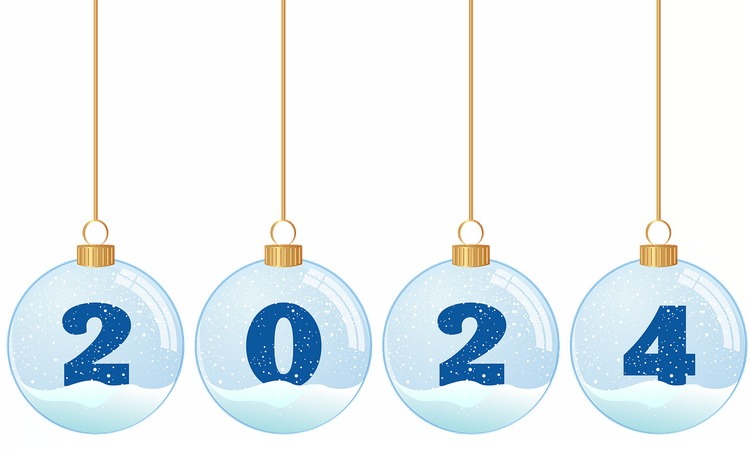
by Nancy Jaffer | Dec 30, 2024
Wait just a few minutes before you pop the cork on that bottle of New Year’s Eve champagne. It’s time to look back over 2024, and give our memories a final airing before heading into 2025.
When we think about the last 12 months, the first thing that comes to mind for many equestrians likely will be the Paris Olympics and Paralympics. Something so anticipated doesn’t disappear from our thoughts just because it’s over. We relive both the moments of glory and those that were not so glorious, while recalling the excitement and disappointments that are inevitable partners.
U.S. riders earned only a single Olympic medal, but it was a good one, silver in show jumping. And our Paralympians took their first team gold, along with a host of other glittering medallions that displayed what a difference the game-changing efforts of the last few years have made for them.
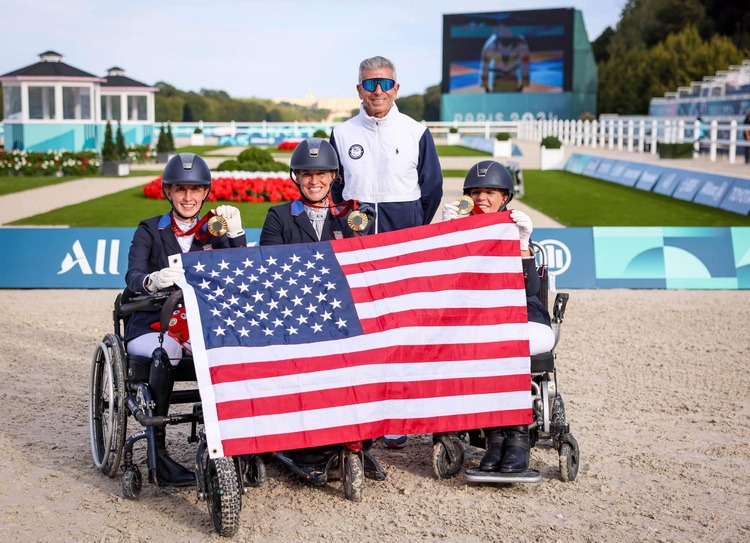
Fiona Howard, Becca Hart and Roxanne Trunnell brought home gold in the Paralympics with chef d’equipe Michel Assouline.
The dark side of the Olympics came before the Games, when a video strategically timed for maximum impact showed British dressage multi-gold medalist Charlotte Dujardin hitting a horse repeatedly with a longe whip during a private clinic.
That put her out of the Games and destroyed Britain’s chances for team gold, though that nation did wind up with the bronze.
But it was fodder for those who call horse sports cruel, and together with a TV documentary about training methods at Andreas Helgstrand’s Danish stable, it played into the hands of those who would like to see an Olympics without horse sports and gave a black eye to dressage.
Social license to operate, or public acceptance of horse sports, cast a large shadow in 2024 and will continue to be a factor every equestrian must consider when they deal with their horses. Someone is always watching – and videoing.
Good news that came from bad news is the creation of the Chromatic fund, named for the show jumper who died during the FEI World Cup Finals in Saudi Arabia after getting an injection of five substances from a U.S. Equestrian Federation-appointed veterinarian.
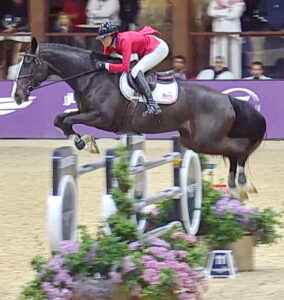
Chromatic competing in Saudi Arabia.
The fund, which has Chromatic’s owner, Kc Branscomb, the USEF and the American Association of Equine Practitioners behind it, will pay for collaborative research and education enabling veterinarians to be updated as they make decisions about horse care at competitions and elsewhere.
Another major story was the heated debate about the showgrounds at Wellington International, home to Florida’s Winter Equestrian Festival. The group that formerly owned the facility is back in charge, with improvements and expansion under way, raising hopes for a better venue.
The Global dressage showgrounds a half-mile away eventually will become the site of a golf development, despite the efforts of those in the community who wanted it to stay the way it was.
Meanwhile, the new Longines League of Nations debuted in the U.S. at the World Equestrian Center in Ocala, Fla., making a big impression on foreign show jumpers during their first visit to that luxurious facility.
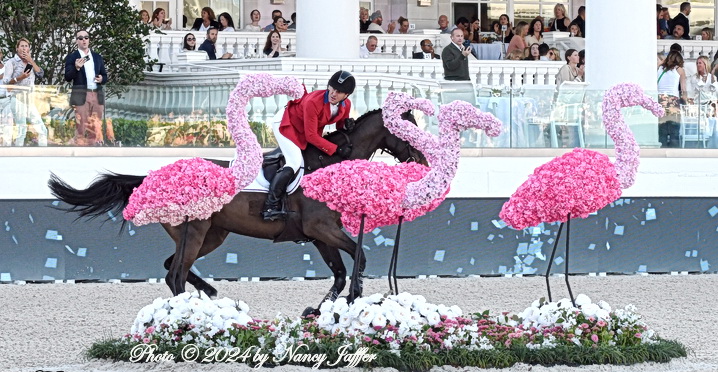
McLain Ward met a flamingo on course at the Longines League of Nations in Ocala. (Photo © 2024 by Nancy Jaffer)
In dressage, Zen Elite Equestrian Center served notice it would be a big player for the U.S. in the discipline, as it bought two horses to be ridden by Olympic veteran Adrienne Lyle. Although she just started with them in January, she did indeed ride one of them, Helix, in the Olympics. As the year ended, Zen Elite continued its investment and bought a Dutch Olympic horse for Adrienne’s 22-year-old student, Christian Simonson.
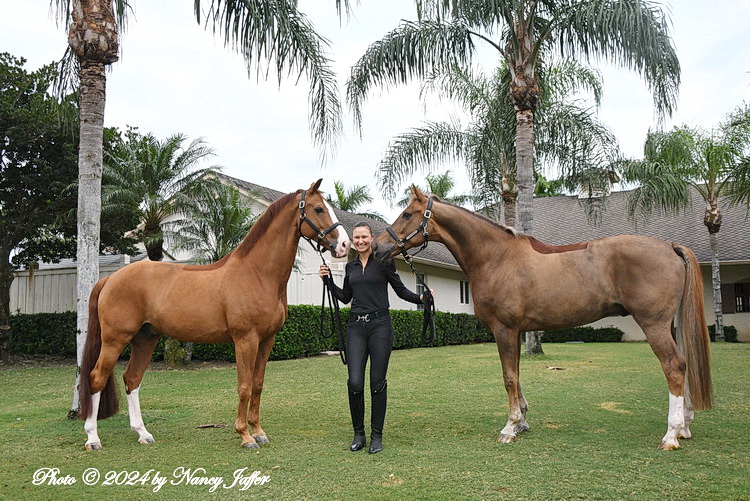
Adrienne Lyle with Zen Elite’s Lars van de Hoenderheide and Helix. (Photo © 2024 by Nancy Jaffer)
The Games were tough for the U.S. team in dressage. It was the last show for Steffen Peters’ veteran Suppenkasper, and not the best way for him to bow out, while Marcus Orlob was eliminated when his ride, Jane, sustained a tiny scratch on her leg and the rider wasn’t allowed to finish his test. Marcus is resilient, and will continue to show that as a newcomer to the top international level, he is no flash in the pan.
In eventing, both U.S. 5-stars, Kentucky and Maryland, were won by Great Britain’s Oliver Townend on Cooley Rosalent and Ballaghmor Class respectively. The 2023 Kentucky winner, Mai Baum, appeared to have a shot in his last 5-star, but he tired on Maryland’s testing cross-country course and Tamie Smith knew when it was time to call it a day.
There was too much sad news from eventing. British rider Georgie Campbell died in a fall at the Bicton Horse Trials in May. Three months later, U.S. Olympian Liz Halliday suffered a traumatic brain injury when her horse fell with her on cross-country at the American Eventing Championships. She still is undergoing therapy.
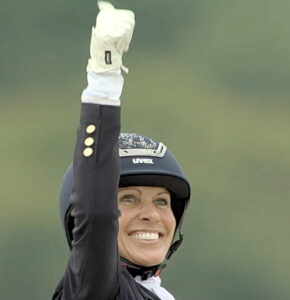
Olympian Liz Halliday.
USEF announced a new competition series with $1 million in prize money for dressage, show jumping and eventing, with an eye toward the 2028 Olympics in California. The first eventing qualifier was held in 2024.
In other headlines from the past year, a judge enabled 2008 Olympic dressage team alternate Michael Barisone to return to his Florida farm, five years after he was charged with second-degree attempted murder in the shooting of a student with whom he had a long-running dispute.
Barisone, who spent time in jail and psychiatric facilities, had been found not guilty by reason of insanity.
The Potomac Horse Center in Maryland, which trained generations of horsemen and women, closed after it was unable to renegotiate its 1993 lease.
The U.S. team won the Aga Khan Cup in Dublin and children of equestrian professionals took top honors in equitation. Taylor Cawley, the third generation of her family to be involved with showing, won both the ASPCA Maclay and the Platinum Performance/USEF Show Jumping Talent Search Finals East.
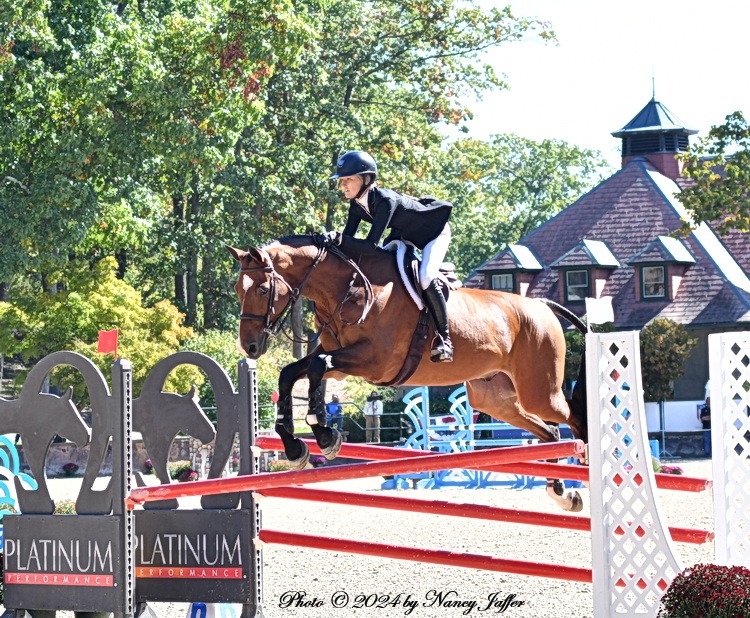
Taylor Cawley won two major equiiation championships in 2024. (Photo © 2024 by Nancy Jaffer)
The Talent Search West went to Avery Glynn, also the daughter of professionals. JJ Torano, whose parents are involved with hunters and jumpers, became the youngest rider, at age 14, ever to win the Dover Saddlery/USEF Medal finals.
If you want to read more about any of these items, go to the “previous columns” icon at the top of the masthead and do a search, or just go through all the stories. A piece about the people who left us this year is linked here.
Wondering what will happen in 2025? Stay tuned, we’ll be doing a story on looking ahead in the new year. Hoping it will be a happy and fulfilling one for you and your horses.

by Nancy Jaffer | Dec 29, 2024
As the year comes to a close, let’s put aside some time for paying tribute to those the equestrian community lost this year.
Be grateful for the contributions they made and rejoice that we knew them — or at least knew of them, and admired what they achieved.
Each made an impact we shouldn’t forget. Whether they were riders, trainers, competition organizers, sponsors or simply someone who cared for the animals, they all were special and had something in common—the love of horses. I can’t mention everyone who left us during the year, but here are some you will remember fondly. Add your own thoughts of others who were special to you.
In early December, the death of Rodney Jenkins was a shock. The hall of fame show jumper and hunter competitor had a natural talent and an understanding of every horse he rode. Though the Red Rider is most identified with Idle Dice and the other outstanding horses he handled with his unique style, he also was successful out of the saddle. After retiring from showing, he became a successful thoroughbred racing trainer, whose horses earned more than $24 million.
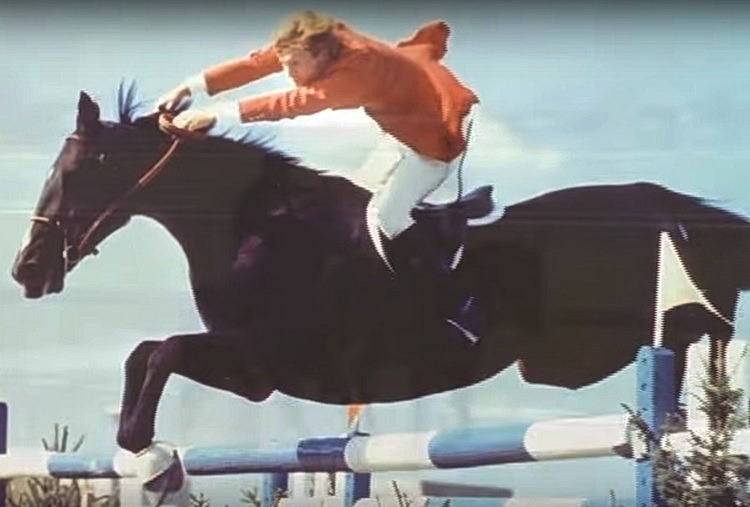
Rodney Jenkins and Idle Dice
A memorial service is scheduled for noon Jan. 7 at Tycoons in the Laurel Park racetrack clubhouse in Maryland. Another celebration of his life will be held June 1 on the grounds of the Upperville, Va., Colt and Horse Show. Read more about Rodney here.
In November, two leading figures on the international scene passed away. Con Power excelled as a pillar of successful Irish show jumping teams. Pehr Gyllenhammar, as the CEO of Sweden’s Volvo, was the power who jump-started the World Cup series of show jumping in 1978, giving riders a goal for the early part of their season with an indoor championship.
During September, we lost gifted show jumper Patty Stovel—who had ridden on the U.S. team at the 1994 World Equestrian Games. Talented with hunters as well as jumpers, she developed many horses, with perhaps the most memorable being Mont Cenis. Read about Patty here.
Jack Levy left us in August. The former president of Miller Harness Co., who went on to Weatherbeeta and then served as a consultant for JPC Equestrian, he was a dynamo who worked constantly. But this team player with a twinkle in his eye always had time to mentor those who asked for his support. Read more about him here.
An ardent advocate for three-day eventing whose involvement in the horse world ran from being a U.S. Pony Club District commissioner to officiating at the Olympics, Trish Gilbert gave wings to the Fair Hill lnternational event and headed successful efforts to bring a 5-star event to Maryland. We lost her in May. Read more about her here.
Others who passed on that we would should mention include Bruce Thompson, who worked tirelessly for rescue horses in Warren County, N.J., at Mylestone Equine Rescue; Cynthia Gardener, a former chair of Wellington, Fla.’s Equestrian Preserve Committee who worked to created the Village’s Equestrian Overlay Zoning District; horse trials organizer Lefreda Williams, an official of the Carolina Horse Park Foundation and the U.S. Combined Training Association (now U.S. Eventing); Margaret “Sissie” Brown Anderton of Brownland Farm, which became a center for breeding, training and horse shows in Tennessee and regional trainer Debbie Haimowitz, who always was ready to lend a helping hand.
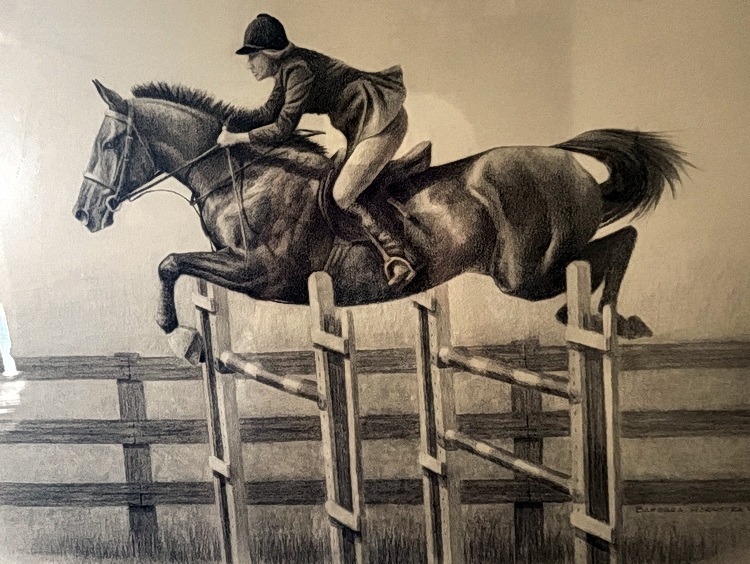
by Nancy Jaffer | Dec 26, 2024
It’s the season for reminiscing, a time to recall the year gone by, which I will do on this website before 2024 ends.
But at the moment, I am reaching further back with my nostalgia; a half-century, in fact, remembering a horse and rider who made their mark in a very different time.
We always celebrate the competitors at the very top of the game, Olympians or professionals who make a living in horse sport. But this story is about an amateur who achieved recognition with her equine partner of a lifetime. It happened before warmbloods dominated the jumper ranks, when what were often considered big money prizes added up to five figures (or even less), and the heyday of horses selling for hundreds of thousands of dollars (or more) was still to come.
A field hunter who had a habit of overjumping his fences went to a horse dealer for dispersal. The gelding, an appendix-registered Quarter Horse without papers, eventually wound up with New Jersey rider Diane Ward. The horse was Traveler, who became a dominant force in the Northeast’s amateur-owner jumper ranks during the 1970s. Anyone who witnessed this pairing will never forget the determined way they conquered the fences; they always drew a crowd.
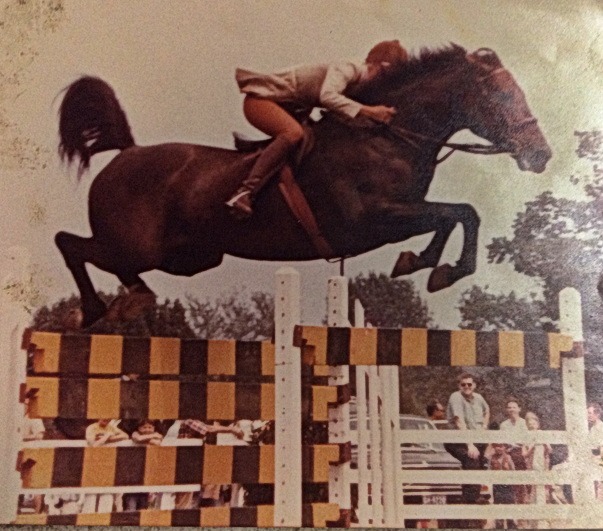
Diane Ward and Traveler airborne in their typical exuberant style.
Traveler took the A-O division’s American Horse Shows Association Horse of the Year title in 1974; yes, 50 years ago, which is why we’re commemorating this anniversary in 2024. Then he did it again in 1976. (AHSA was one of the predecessors of the current U.S. Equestrian Federation).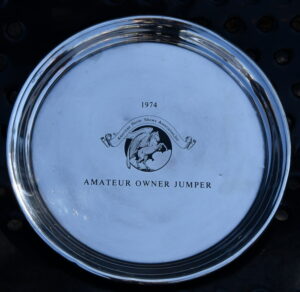
The memorable partnership began this way: Diane’s friend, Jo Iacono, bought Traveler from the dealer in 1969 (or so) after Diane tried him out for her and then showed him. But the dynamic horse didn’t turn out to be Jo’s type of ride.
“He wasn’t broken well on the flat,” recalled Diane, who noted, “riding on the flat, at least with the jumpers, is 50 percent of your ballgame. You don’t just get on and go to a fence.” But when it came time to ride a course, Traveler could jump with enthusiasm and accuracy, getting sharper with more training..
Diane was in the saddle when he demonstrated his prowess by winning in Preliminary jumpers (a division based on prize money won that doesn’t exist anymore) at the old Middlesex County show in New Brunswick, N.J., one of the state’s biggest fixtures at the time.
“This is a horse I want,” decided Diane, who had a limited budget. She didn’t let that stop her, however.
“We negotiated, sitting around all day. How much was I going to pay for him?” remembered Diane, who had ridden the horse all year and spent the winter doing dressage work with him.
The price was $5,000, an unreachable figure for the prospective buyer. Diane finally talked her way into paying $2,800, which was her limit, to get the horse. He turned out to be a bargain.
As a child, Diane began taking saddle-seat lessons in West Virginia. When her family moved to Smoke Rise in Kinnelon, N.J., she informed her parents that she wasn’t going unless they bought her a horse. That’s how the Morgan mare, Caramel, came into her life.
She remembers showing Caramel in saddle-seat classes at the old Junior Essex Troop Show in West Orange, N.J., during the mid-1950s. Trainer Vic Goines, who coached riders at Oakland Academy, felt Caramel would fit in well with the school’s program. So that’s where she and Diane went.
Patricia Byrne, who would later become one of Diane and Traveler’s chief rivals with another quarter horse, East Side Drive, remembered Diane from her own early days working with Vic.
“I knew nothing, was totally in awe when watching Diane ride,” recounted Patricia, now a horse show official.
Diane moved on to work with trainer Ben Purifoy at Smoke Rise in Kinnelon, N.J. In 1971, after buying Traveler, she started the year as amateur-owner jumper champion at the Saratoga, N.Y. show. Traveler competed against such well-known pairings as Michele McEvoy (now Grubb) with Advance Ticket and Melanie Smith (now Taylor) who rode The Irishman in amateur classes and was the division’s national champion in 1970. (She eventually rose from the amateur ranks to compete internationally and won team gold at the 1984 Olympics with Calypso.)
Melanie remembers that the combination of Diane and Traveler was one “to always watch, and hope you went after them in the jump-off” in order to beat the sizzling clockings they set.
Pat Campbell, who also competed around that time, recalled Traveler as “just an incredible horse, fun to watch.”
Patricia, who would take the national amateur-owner title in 1977 with East Side, commented about Diane, “She was always the one to try and beat. Traveler was lightning fast, turned on a dime and Diane was a fierce competitor.”
In 1972, things were off to a promising start for Diane and Traveler. They went to the old Winter Haven show in Florida, got the championship again at Saratoga, and did well at Ox Ridge and Fairfield. Then Traveler competed at a small show in New Jersey as a tune-up and stepped on a rock.
“That was it for the year,” noted Diane, noting the veterinarians were stumped trying to find out what was wrong with the horse.
Meanwhile, Pete Bausum, a nephew of one of her friends, had recently graduated from the University of Pennsylvania veterinary school and examined Traveler. He X-rayed Traveler and found a crack in his coffin bone. That started Diane’s friendship with Pete, who became a top practitioner.
The choice of treatment was “complete stall rest or nerve him.” In response, Diane said, “I’m not nerving him,” so stall rest it was.
During the horse’s recovery, farrier Ralph Snyder built Traveler a special cast-type support shoe. The horse was out of action for close to a year, recuperating while on stall rest, a difficult situation for an animal that previously had been worked every day.
Traveler came back in May 1973, after nearly a year off, and finished fourth in the national standings. He was just warming up.
“In 1974, he was unbelievable, he kept winning,” said Diane, of Traveler’s first national championship year. He was profiled in the yearbook, “Champion Horses and Riders of North America,” a volume put together by former U.S. Equestrian Team Executive Director Jack Fritz.
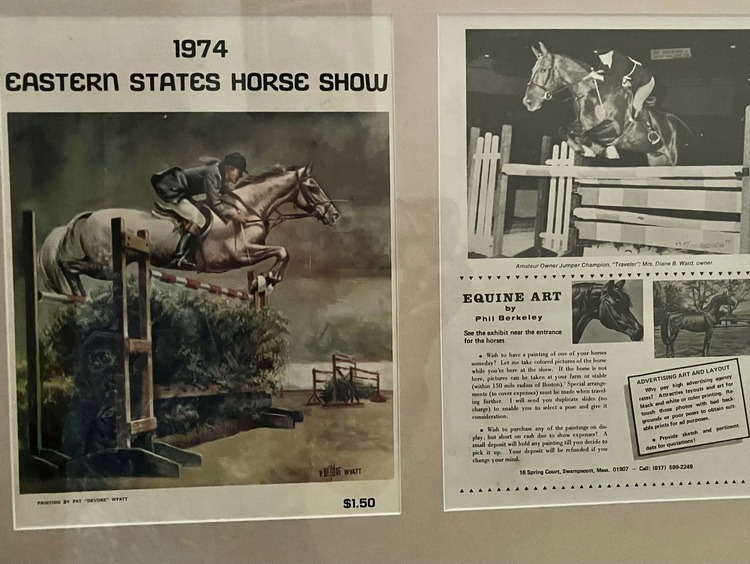
The program from the 1974 Eastern States Horse Show, where a photo of Traveler was featured (upper right).
Among the titles that Traveler won was the A-O championship at the North Shore Horse Show on Long Island. That has special significance to Diane because actor Paul Newman presented the trophy.
After a relatively quiet 1975, Traveler earned the national championship again in 1976. Diane had a lot of offers from people who wanted to buy Traveler. Some bids were around $30,000, “which in those days was pretty good money,” the horse’s owner pointed out, but she had no intention of selling her amazing partner.
Traveler earned enough money in the amateur ranks to qualify for the glamorous open jumper division in 1971 at the National Horse Show, which was one of the highest-profile events at the old Madison Square Garden, between forty ninth and fiftieth streets in Manhattan. (The current Garden opened above Penn Station in 1968).
“I sent the entry form in as a lark,” said Diane. After learning she had been accepted, she thought, “I hoped I wasn’t in over my head.”
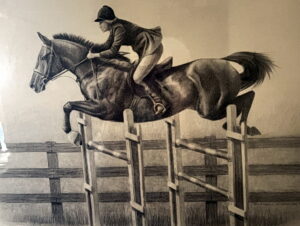
The portrait of Traveler and Diane that hangs in her livingroom.
She cleared the National’s storied puissance wall at 6-feet, 6 inches, but was understandably nervous about trying anything that was bigger (puissance competitions often went to 7 feet or more).
In the next round, “I was so glad he brought the back rail of the spread fence down (a required obstacle in the class) because I didn’t want to jump any higher,” she said.
Traveler got third-place and fifth-place ribbons at the show, competing against the legendary Idle Dice with Rodney Jenkins and The Cardinal, another star of that era, ridden by Bernie Traurig.
After taking the AHSA A-O championship in 1976, Diane turned professional and retired Traveler from high-level competition. Her daughter rode “Trav,” as Diane called him, in the junior jumpers, and eventually Diane started using him for flat lessons. But she had to be careful:
“You couldn’t let him see a jump. He’d just point at it and go. He taught so many kids over the years to walk, trot and canter until he was in his 30s. Even a 5-year old could ride him.”
Diane’s Jack Russell also used to get on his back. Traveler was used in a lesson the day before he died at age 33 in 1993.

Diane Ward with her AHSA championship ribbons and plaque.
Diane moved to Ocala, Fla., from New Jersey, after her husband, Don, passed away in 2012.
“I fell in love with the place, with the trees. It’s a gorgeous area,” said Diane who lives 10 minutes from the World Equestrian Center and can go there to watch her fill of the jumpers.
With her own showing days long over, she keeps busy volunteering at VOCAL for Pets, (Voices of Change Animal League) a welfare group that offers everything from low-cost spaying and neutering to foster care and vaccinations. Diane is involved with their fundraising Fur Ball and a pet food program that has her unloading pallets of feed every Sunday.
Though Traveler has been gone since 1993, he is still a presence for Diane. A drawing of him hangs in her living room, where she sees it every day. The gelding was more than a brilliant competitor, he had a special personality to go with his athletic ability.
“He was not really a horse,” Diane contends.
“He was like a dog, he would follow you anywhere. He was so good to so many people.”
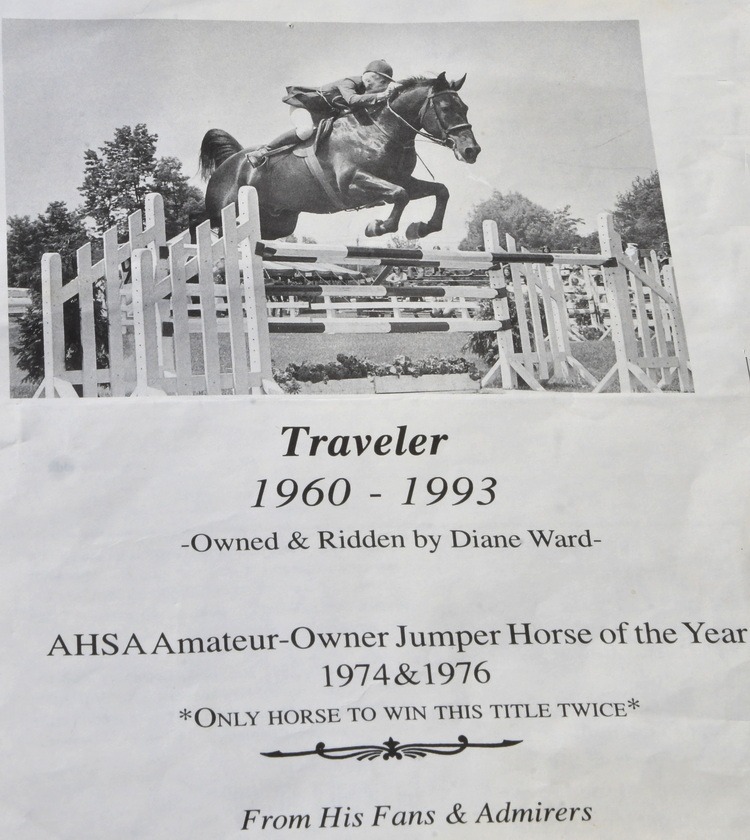
A memorial ad for Traveler.

























